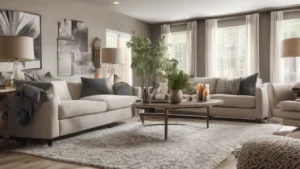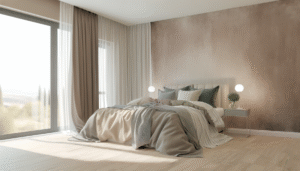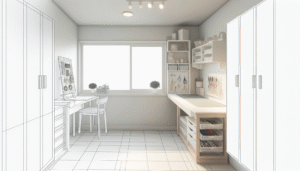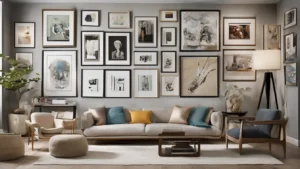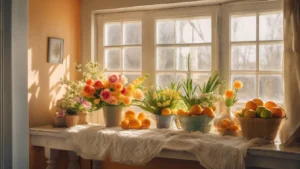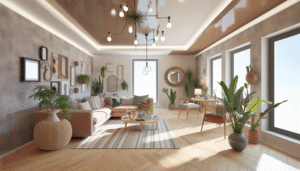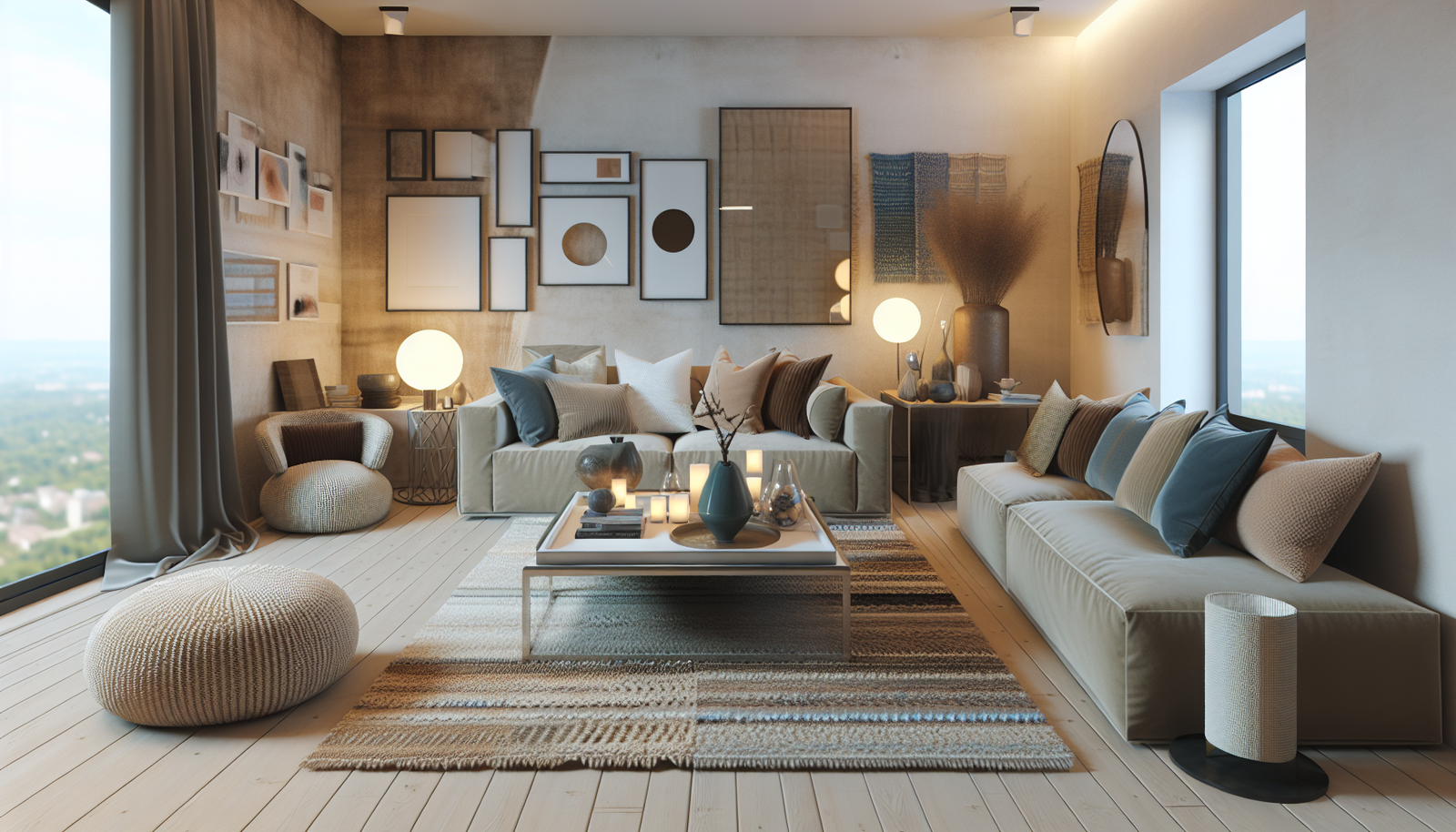
Why One Rug Isn’t Enough: The Power of Layering for Visual Depth
for full implementation) –>
You’ve meticulously chosen a stunning rug for your living room. It’s beautiful, anchors the furniture, and theoretically completes the space. Yet, something feels… missing. That’s a common dilemma in interior design, and the answer often isn’t another piece of furniture or a splash of paint. The secret to achieving that coveted “designer look” often lies in a surprisingly simple yet powerful technique: **layering rugs**. It’s about transforming a flat, one-dimensional floor into a tapestry of textures, patterns, and visual interest, adding remarkable depth and personality to any room.
One rug simply isn’t enough to capture the full potential of your space. Layering rugs isn’t just a fleeting trend; it’s a sophisticated design strategy that can dramatically alter the perception and feel of a room, making it feel warmer, more inviting, and undeniably stylish. This comprehensive guide will unravel the mysteries of rug layering, from understanding its fundamental principles to mastering advanced techniques. We will explore how to select the right rugs, combine different styles, and troubleshoot common challenges, ensuring your layered creation is a testament to your refined taste. Prepare to unlock a new dimension in your home decor, creating spaces that truly speak volumes.
In this expansive article, you’ll discover why layering rugs is a game-changer for visual depth, learn actionable strategies for selecting and arranging your textiles, and gain insights into creating harmonious, aesthetically pleasing environments. We’ll delve into the psychology behind warmth and comfort in design, explore various combinations that work for different rooms, and ultimately empower you to transform your home with this impactful design method. Move beyond single-rug simplicity and embrace the rich complexity that only thoughtful layering can provide.
The Unseen Power of Layering Rugs: Beyond a Single Surface
For decades, the standard approach to floor coverings involved a single, often large, area rug placed centrally within a room. While effective for defining spaces, this method frequently falls short of adding true character. The power of **layering rugs** lies in its ability to break free from this convention, creating a multi-faceted floor narrative. It’s not merely about putting a smaller rug on top of a larger one; it’s a deliberate act of design that builds visual depth, introduces varied textures, and injects personality that a lone rug cannot achieve.
Consider a blank canvas. A single brushstroke creates a line, but multiple layers of paint, varying in thickness and hue, build a complex, intriguing image. Similarly, a single rug offers a baseline, but layered rugs introduce intricate patterns, tactile differences, and unexpected visual pathways that draw the eye and engage the senses. This technique combats blandness, adds softness underfoot, and helps to anchor furniture with a greater sense of purpose and style.
Why One Rug Falls Short: The Limitations of Monochromatic Floors
A solitary rug, no matter how exquisite, often struggles to carry an entire room’s aesthetic weight. It can define a zone but rarely creates the rich, nuanced feel of a well-decorated space. Imagine a living room with a single greige rug. While functional, it might leave the room feeling sterile or incomplete. It lacks the tactile appeal and visual complexity that defines a truly curated interior.
The primary limitations of a single rug include:
- **Lack of Visual Texture:** A uniform surface can feel flat. Layering introduces contrasting textures like jute and sheepskin, or wool and silk, adding significant tactile interest.
- **Understated Character:** While a large rug can be bold, it often acts as a backdrop. Smaller, layered rugs can be chosen for their unique patterns or colors, becoming focal points.
- **Limited Zoning Flexibility:** A single rug often dictates one large zone. Layering allows for the creation of sub-zones within a larger area, offering greater functional versatility.
- **Perceived Coldness:** Especially in modern or minimalist settings, a single rug might not provide enough warmth or coziness, leaving the room feeling large and impersonal.
- **Difficulty in Hiding Imperfections:** A single rug must be perfectly sized and placed. Layering offers flexibility, allowing smaller, more decorative rugs to draw attention away from awkward floor gaps or less-than-perfect base rugs.
These shortcomings highlight the need for a more dynamic solution, a role perfectly filled by the strategic deployment of layered rugs. It’s about moving beyond simply covering the floor to actively designing a multi-sensory foundation for your entire room.
Defining Visual Depth: More Than Just Appearance
When we talk about visual depth in interior design, we’re referring to the perception of three-dimensionality and complexity within a two-dimensional space. It’s what makes a room feel rich, inviting, and considered, rather than flat and uninteresting. **Layering rugs** excels at this, creating distinct planes and contours on the floor that trick the eye into perceiving more space and intricate detail.
This depth isn’t just superficial; it contributes to:
- **Enhanced Interest:** The eye has more to explore, moving from one texture or pattern to another.
- **Cozy Ambiance:** Multiple layers of textiles inherently suggest warmth and comfort, turning vast spaces into intimate nooks.
- **Dimensionality:** Instead of one flat surface, you create varied heights and textures, adding a sculptural quality to your floor.
- **”Collected” Feel:** Layered rugs often look as if they’ve been gathered over time, contributing to a sense of history and curation, moving beyond a “showroom” aesthetic.
Achieving visual depth through rug layering is an art form that transforms the mundane into the magnificent. It’s about building a foundation that supports and elevates every other element in your room.
The Psychology of Comfort: How Layered Rugs Create Welcoming Spaces
Beyond aesthetics, there’s a profound psychological impact to a well-layered floor. Our homes are meant to be sanctuaries, and the textiles we choose play a crucial role in creating a sense of warmth, security, and well-being. **Layering rugs** harnesses ancient human instincts, drawing us into spaces that feel soft, protected, and visually stimulating.
Building Warmth and Softness Underfoot
Imagine stepping onto a cold, hard floor versus sinking your toes into layers of plush rug. The difference is immediate and visceral. Layered rugs provide an unparalleled level of warmth and softness underfoot, crucial for creating truly comfortable living environments. This isn’t just about insulation; it’s about the sensory experience.
- **Tactile Pleasure:** Multiple textures invite touch, stimulating a sense of luxury and comfort. Think of the contrast between a rough jute base and a shimmering silk or plush wool top layer.
- **Acoustic Benefits:** Rugs, especially layered ones, effectively absorb sound, reducing echo and creating a quieter, more serene atmosphere. This makes conversations easier and rooms feel calmer.
- **Thermal Insulation:** An additional layer of rug provides extra insulation against cold floors, particularly in older homes or ground-floor rooms.
This enhanced physical comfort translates directly into psychological comfort, making a room feel more like a refuge. It’s why libraries and cozy reading nooks often feature plush textiles—they create an inviting atmosphere.
Creating Zones and Defining Functions within Open Concepts
Open-concept living spaces, while popular, can often feel expansive and undefined. **Layering rugs** is an exceptionally effective tool for segmenting these large areas into distinct, functional zones without the need for physical barriers. This technique helps to “ground” furniture groupings and give purpose to each area.
Consider a large great room. A substantial primary rug might anchor the main seating area. Then, a smaller, contrasting rug could define a cozy reading nook within that seating area, perhaps under a single armchair and side table. Or, in a dining area adjacent to a living space, a textured rug larger than the dining table could separate it from the rest of the room. This strategic zoning:
- **Improves Navigation:** Guides the eye and feet, making the flow of the room more intuitive.
- **Adds Intimacy:** Breaks down vastness into human-scale segments, making each zone feel more personal and contained.
- **Enhances Organization:** Visually tidies the space, giving each furniture grouping a clear home.
This approach is more flexible and visually interesting than using multiple, unconnected rugs, which can sometimes make a room feel chaotic. Layering creates a unified yet segmented whole.
Infusing Personality and Curated Style
Your home should tell your story. **Layering rugs** offers an unparalleled opportunity to infuse personal style and create a curated look that feels genuinely unique. It allows for a playful exploration of patterns, colors, and global aesthetics that a single rug often limits.
- **Express Individuality:** Combine a vintage kilim with a modern geometric pattern, or a tribal rug with a minimalist solid, to showcase your eclectic taste.
- **Tell a Story:** Mix rugs from different cultures or eras to evoke a sense of travel and history.
- **Add Unexpected Elements:** A surprising animal hide over a neutral jute rug adds a touch of bohemian chic or rustic charm.
- **Adaptability:** Layering allows you to incorporate smaller, more expensive, or sentimental rugs (like a hand-me-down heirloom) which might be too small on their own to shine.
The beauty of this technique is its adaptability. You can easily swap out the top rug for a seasonal change or to experiment with a new aesthetic, giving your room a fresh perspective without a complete overhaul. It’s a testament to the idea that design should be dynamic and evolving, not static.
Mastering the Art: Essential Principles for Successful Rug Layering
While the concept of **layering rugs** might sound simple, achieving a cohesive and visually pleasing result requires a strategic approach. It’s not just about throwing two rugs together; it’s about understanding contrast, proportion, and balance. Mastering these essential principles will empower you to create stunning, harmonious layered compositions in any room.
Foundation First: Selecting the Base Rug
The base rug is the anchor of your layered composition. It’s typically the larger of the two (or more) rugs and serves as the foundation upon which your top layers will rest. A strong base rug is crucial for both visual stability and practical functionality.
- **Size Matters:** The base rug should be large enough to define the entire area you’re zoning. In a living room, it should ideally extend under the front feet of all major seating pieces. For a dining room, it should accommodate the table and chairs, even when pulled out. This creates a cohesive “island” for your furniture.
- **Neutrality or Subtlety:** Most often, the base rug should be relatively neutral in color and pattern. Think solid natural fibers like jute, sisal, seagrass, or a large, subtly patterned wool rug. This provides a calm backdrop that allows your top rug to truly pop.
- **Texture as Key:** Even if neutral in color, a base rug with interesting texture (e.g., a chunky knit wool or a woven jute) adds depth without competing with the top layer’s pattern.
- **Durability:** As the larger, more exposed rug, the base layer should be durable and easy to maintain.
A common mistake is choosing a base rug that is too small, leaving furniture floating and the layered effect looking disconnected. Ensure your base rug covers enough square footage to truly ground your space. For instance, a 9×12 jute rug provides an excellent, versatile foundation for most living room setups, allowing you to layer a 5×7 or 6×9 rug on top.
The Star of the Show: Choosing the Top Rug
The top rug is your opportunity to introduce personality, bold patterns, and vibrant colors. This is where you can truly express your style and make a statement. It sits atop the base, usually centered or strategically offset, drawing immediate attention.
- **Contrast is Key:** The top rug should contrast with the base in at least one significant way: color, pattern, or texture. If your base is neutral and textured, your top rug could be colorful and patterned (e.g., an Oushak or Persian rug). If your base has a subtle pattern, choose a solid or highly textural top.
- **Size and Placement:** The top rug should be significantly smaller than the base rug, typically leaving 12-24 inches of the base rug exposed around its perimeter. Often, a 5×7 or 6×9 rug works well over a 8×10 or 9×12 base. It should be positioned to highlight a specific area, such as directly under a coffee table or in front of a fireplace.
- **Pattern Play:** Experiment with patterns! A geometric over an organic texture, or a floral over a subtle stripe. The key is that the patterns complement without clashing. Avoid two highly busy patterns unless they share a very clear color palette.
- **Luxe Factor:** This is often where you can introduce a more luxurious or delicate material like a vintage silk rug, a plush sheepskin, or a soft, high-pile wool.
Don’t be afraid to let your top rug be the conversation starter. It’s the decorative cherry on top of your layered creation, designed to captivate and charm.
Texture, Pattern, and Color: The Trifecta of Layering
Successful rug layering hinges on a harmonious interplay of texture, pattern, and color. These three elements are your primary tools for building visual depth and aesthetic appeal.
- **Texture:**
- **Importance:** Texture adds tactile interest and a sense of luxury. Avoid layering two rugs with the exact same pile height and finish.
- **Combinations:** A rough, natural fiber (jute, sisal) base with a soft, plush (wool, shag, sheepskin) top creates immediate contrast. A flat-weave base can be paired with a cut-pile top.
- **Impact:** Varying textures make a room feel richer and more inviting, stimulating the sense of touch.
- **Pattern:**
- **Importance:** Patterns add visual energy and can guide the eye.
- **Combinations:**
- **Solid + Pattern:** The safest and most common approach. A solid base with a patterned top (e.g., natural fiber jute + Persian oriental).
- **Small Pattern + Large Pattern:** Ensure the patterns are distinct in scale. A subtle striped base with a bold geometric top.
- **Two Different Patterns:** Can work if their colors are complementary or muted, and if the patterns have different scales or origins (e.g., a subtle trellis base with a bold Moroccan Beni Ourain).
- **Avoid:** Two patterns of similar scale or intensity fighting for attention.
- **Color:**
- **Importance:** Color sets the mood and ties the composition together.
- **Schemes:**
- **Monochromatic:** Different shades and tints of the same color, relying heavily on texture for depth.
- **Complementary:** Colors opposite on the color wheel (e.g., blue and orange), creating vibrancy.
- **Analogous:** Colors adjacent on the color wheel (e.g., blue, green, and blue-green), creating a harmonious, serene feel.
- **Strategy:** Often, a neutral color base allows the top rug to introduce a significant color pop. Alternatively, choose two rugs within the same broad color family but with differing saturations.
Experimentation is key, but always step back to assess whether the different elements are working in harmony or creating visual chaos. The goal is pleasing complexity, not clutter.
Strategic Combinations: Layering Rugs for Every Room
The beauty of **layering rugs** lies in its versatility. This technique isn’t confined to a single room; it can elevate the aesthetic and functionality of virtually any space in your home. From formal living rooms to cozy bedrooms and bustling entryways, strategic rug combinations can infuse personality and purpose.
Living Room Layering: Anchoring and Defining
The living room is perhaps the most natural canvas for rug layering, given its dual role as a high-traffic area and a relaxation zone. Here, layering can serve to anchor large furniture groupings while adding comfort and a focal point.
- **Base (8×10 or 9×12):** A large, durable, and neutral rug is ideal. Think a natural fiber like jute, sisal, or a low-pile wool rug in a solid cream, grey, or beige. This base should extend under at least the front legs of your sofa and armchairs.
- **Top (5×7 or 6×9):** This is where you introduce your statement piece. A vintage Persian or Turkish rug, a plush Beni Ourain, a high-pile shag, or a textured cowhide.
- **Placement:** Centered on the base rug, often directly under the coffee table, allowing 12-24 inches of the base to show around all sides of the top rug.
- **Effect:** The layered rug clearly defines the seating area, adds softness underfoot for guests, and injects a vibrant splash of color or pattern, drawing the eye. It creates a sense of luxurious density.
For a grand living room, consider a large geometric or abstract art silk rug as the top layer over a plain wool base to create a contemporary focal point.
Bedroom Bliss: Softness and Sanctuary
In the bedroom, comfort is paramount. **Layering rugs** here enhances the feeling of sanctuary, making the space feel incredibly soft, warm, and inviting – perfect for bare feet in the morning.
- **Base (8×10 or 9×12):** A large, soft rug that extends from under the bed, covering the walking paths on either side. A plush wool, synthetic, or even a soft flat-weave rug works well. Color can be calm and muted.
- **Top (2×3 runners, 3×5, or a small sheepskin):** Place these strategically. Two narrow runners on either side of the bed, a smaller decorative rug at the foot of the bed or to one side, or even a plush sheepskin draped over the larger base rug directly where your feet will land.
- **Placement:** The base rug should be positioned horizontally under the bed with about a foot or two extending beyond the foot of the bed. Top rugs are then placed on top for added softness and visual interest.
- **Effect:** Maximizes softness underfoot, especially on cold mornings. Adds a layer of luxurious texture and can introduce a subtle pattern or color accent without overwhelming the calm of the bedroom. A sheepskin on top of a low-pile rug creates an irresistible tactile experience.
Consider placing a small, highly decorative rug off-center, pointing towards a reading chair or window for an unexpected touch.
Dining Room Drama: Practicality Meets Style
Layering rugs in a dining room requires careful consideration of practicality due to spills and chair movement. However, done right, it can add significant warmth and elegance.
- **Base (at least 8×10, ensuring chairs stay on when pulled out):** A durable, low-pile, and easy-to-clean rug is essential. Flat-weave wool, synthetic easy-care rugs, or even an outdoor-friendly rug can work as a base. Choose a pattern or color that can handle potential spills.
- **Top (5×7 or 6×9):** A smaller, more decorative rug that perhaps focuses solely on the area directly under the dining table, or offset to define a buffet area. A washable cotton rug or even a vintage kilim can add character.
- **Placement:** The base rug must be large enough that when dining chairs are pulled out, all four legs remain on the rug. The top rug can then be centered underneath the table or placed slightly off-center for a more eclectic look.
- **Effect:** Adds warmth and sound absorption, which is particularly beneficial in dining areas. Visually defines the dining space from an open-concept living area. The top rug can introduce a burst of color or a unique pattern, turning the dining area into a stylish destination.
For a unique touch, consider layering a round rug over a rectangular base in a square dining space to play with geometric forms.
Entryways and Hallways: Welcoming with Layers
Entryways and hallways are transitional spaces that set the tone for your home. Layering here can make these often-overlooked areas feel welcoming and provide additional protection for your floors.
- **Base (Runner or small area rug):** A durable rug, perhaps an outdoor-friendly synthetic or a sturdy flat-weave, that can withstand high traffic and dirt.
- **Top (Small accent rug, doormat, or animal hide):** A charming small rug, a distinctive doormat, or even a faux animal hide placed strategically at the entrance.
- **Placement:** Place the base rug down first, then the smaller top rug overlapping a portion of the base, perhaps right at the threshold or slightly into the hall.
- **Effect:** Creates a luxurious entry, catches more dirt and debris, and adds a decorative flourish. It’s an unexpected touch that makes a strong first impression.
A smaller, beautifully patterned welcome rug layered over a functional coir mat at the very entrance provides both utility and undeniable style. Remember to use rug pads to prevent slipping in high-traffic zones.
Beyond the Basics: Advanced Layering Techniques and Aesthetic Considerations
Once you’ve mastered the fundamental principles, you can begin to explore more nuanced and creative ways to incorporate **layering rugs** into your home. These advanced techniques delve into unconventional pairings, unexpected shapes, and a deeper understanding of spatial dynamics, allowing you to truly push the boundaries of design.
Playing with Shapes: Beyond Rectangle on Rectangle
Most layering examples feature rectangular rugs, but stepping outside this convention can produce striking results. Incorporating different shapes adds an extra layer of visual complexity and artistic flair.
- **Round Over Rectangle:** A round rug layered over a rectangular base creates a soft, organic focal point in a seating area or under a round dining table. This juxtaposition of shapes is visually very appealing.
- **Animal Hide Over Rectangle (or other shapes):** The organic, irregular shape of a cowhide or sheepskin (real or faux) provides a beautiful contrast to the structured lines of a rectangular base. This works exceptionally well in rustic or bohemian-inspired spaces.
- **Multiple Smaller Rugs:** Instead of one large base and one top, consider a large base with two or three smaller, irregular rugs (like smaller sheepskins or animal hides) placed at angles or slightly overlapping in different areas, creating a “patchwork” effect.
This technique prevents your floor from feeling too linear and adds a dynamic, sculptural quality to the composition. It’s about breaking predictable lines and introducing unexpected visual elements.
Monochromatic Magic: Depth Through Texture Alone
You don’t need bold colors or contrasting patterns to achieve impressive visual depth with **layering rugs**. A monochromatic scheme, where rugs are variations of the same color, relies almost entirely on texture to create interest and complexity.
- **Strategy:** Choose a base rug and a top rug that are both, for example, varying shades of cream, grey, or blue.
- **Texture is Paramount:** Here, the difference in pile height, weave, and material becomes critical. A flat-weave grey wool base could be topped with a plush, high-pile grey shag. Or a smooth cotton base could host a textured, woven sisal.
- **Subtle Sophistication:** This approach results in an incredibly sophisticated, serene, and understated look. It’s perfect for minimalist or Scandinavian-inspired interiors where calm and tactile richness are prioritized over bold statements.
- **Lighting:** Natural and artificial lighting sources will play off the varying textures, creating subtle shadows and highlights that enhance the perceived depth.
This method focuses on tactile luxury and a calming aesthetic, proving that depth isn’t solely about vibrant contrasts, but also about refined textual differences.
Rugs as Art: Framing a Masterpiece
**Layering rugs** can also be used as a clever way to frame and highlight a particularly special or expensive rug. If you own a cherished vintage Persian rug or a custom-made art rug that is too small to anchor a room, layering provides the perfect solution.
- **The “Frame”:** Use a large, simple, and affordable base rug (like a plain jute or basic wool) as a neutral frame.
- **The “Art”:** Place your smaller, more precious rug directly in the center of this base, allowing a generous border (18-30 inches) of the base rug to show.
- **Protection and Display:** This approach not only makes the smaller rug appear grander and more substantial but also protects it from high traffic by placing it on top of a more durable base. It elevates the rug from a simple floor covering to a focal point, much like a piece of wall art.
- **Versatility:** This is an excellent way to incorporate heirloom rugs or unique finds that might not otherwise fit the scale of your room.
This “rug as art” concept turns your floor into a gallery, showcasing a textile piece that might otherwise be overlooked or feel insufficient on its own.
Practical Considerations and Troubleshooting for Layering Rugs
While the aesthetic benefits of **layering rugs** are clear, there are practical aspects to consider to ensure your layered setup is not only beautiful but also functional, safe, and long-lasting. Addressing these points upfront will prevent common frustrations and ensure successful implementation.
Preventing Slips and Bunching: The Importance of Rug Pads
One of the most critical practical considerations when layering rugs is stability. A slipping or bunching rug is not only unsightly but also a significant safety hazard. Rug pads are non-negotiable for both the base and potentially the top rug.
- **For the Base Rug:** A high-quality, non-slip rug pad underneath your large base rug is essential. This prevents the entire foundation from shifting, protects your hard floors, and extends the life of the rug by providing a cushioning barrier.
- **For the Top Rug:** Depending on the material and weight of your top rug, you may also need a smaller, non-slip rug pad between the top rug and the base rug. This is especially true for lighter rugs or those with a smooth backing (like some cottons or silks).
- **Types of Pads:**
- **Grip Pads:** Thin, waffle-like pads that provide suction to prevent slipping. Good for preventing movement.
- **Cushion Pads:** Thicker pads that offer extra padding, sound absorption, and insulation, while also preventing movement. Ideal for comfort and rug longevity.
- **Trimming:** Always trim your rug pad about an inch or two smaller than the rug itself on all sides to keep it out of sight.
Invest in good rug pads. They are a small expense that makes a tremendous difference in the safety, comfort, and longevity of your layered rug setup.
Cleaning and Maintenance of Layered Textiles
Layering rugs means you have multiple textiles to care for, which can sometimes complicate cleaning. However, with a smart approach, maintenance is manageable.
- **Routine Vacuuming:** Regularly vacuum both rugs. Ensure your vacuum cleaner has adjustable height settings or is suitable for multiple pile heights. For fringe, use a low suction setting or sweep carefully.
- **Spot Cleaning:** Address spills immediately. Blot, don’t rub. Use appropriate cleaning solutions for each rug’s material. Keep specific cleaning instructions for synthetic vs. natural fibers vs. silk.
- **Deep Cleaning:** Consider professional cleaning for both rugs periodically, especially for wool or delicate materials. If using a large, durable base rug (like jute), it might require less frequent deep cleaning than a more delicate top rug.
- **Rotating:** Occasionally rotate your rugs (especially the top one) to ensure even wear patterns, although this is less critical than for standalone rugs.
- **Accessibility:** When layering, the individual rugs usually remain distinct pieces that can be separated for more thorough cleaning or airing out, a benefit over wall-to-wall carpeting.
Choosing durable and relatively easy-to-clean base rugs can simplify overall maintenance, allowing your top rug to be more decorative and less about heavy-duty resilience.
Overcoming Common Challenges
Even with careful planning, some challenges can arise when layering rugs. Knowing how to troubleshoot these issues can save you time and frustration.
- **”Too Busy” Look:** If your layered rugs feel overwhelming, simplify one or both components. Perhaps one rug has too bold a pattern, or the colors clash. Try swapping one rug for a more neutral option, or opt for a different texture instead of a second pattern.
- **Uneven Surfaces/Tripping Hazard:** This usually indicates insufficient rug padding or a significant difference in rug thickness at the edges. Ensure your rug pads extend close to the edge of each rug, and consider transition strips if the height difference is extreme (though this is rare with standard rug layering).
- **Rugs Sliding Apart:** This almost always points to a lack of proper rug pads or using low-quality pads. Invest in better non-slip pads specifically designed for rugs on rugs if you’re experiencing this between layers.
- **Wrong Proportions:** If the top rug looks like a postage stamp on the base, or if they are too similar in size, the proportions are off. Ensure at least 12-24 inches of the base rug are visible around the top rug. Adjust rug sizes accordingly.
- **Dust and Debris Accumulation:** More layers mean more fabric to collect dust. Regular, thorough vacuuming is your best defense. Consider placing layered rugs in areas with less active foot traffic if you’re concerned about excessive dust.
By anticipating these potential issues and applying these solutions, you can create a gorgeous, functional, and long-lasting layered rug arrangement that elevates your home’s aesthetics and comfort.
Case Studies in Layering: Real-World Inspiration
To truly grasp the transformative power of **layering rugs**, it helps to examine how designers and homeowners have successfully applied these principles in various settings. These real-world examples showcase diverse styles and demonstrate the versatility of this technique.
Rustic Charm Meets Boho Chic: The Jute & Kilim Combo
**Scenario:** A spacious, bright living room with distressed wood floors, exposed beams, and comfortable, neutral-toned linen furniture.
- **Base Rug:** A large 9×12 natural fiber jute rug. Its coarse, organic texture and earthy tones provide a durable, understated foundation that grounds the room and complements the rustic elements. Explore Jute Rugs on Wayfair.
- **Top Rug:** A vibrant, vintage 5×7 Turkish kilim rug with geometric patterns in blues, oranges, and creams. The flat-weave kilim introduces a rich cultural story, a pop of color, and a striking pattern that contrasts beautifully with the simplicity of the jute.
- **Effect:** The combination of rough, natural jute with the intricate, colorful kilim creates a compelling interplay of textures and patterns. It introduces a free-spirited, collected bohemian vibe while the neutral base maintains a grounding element. This setup adds immense visual depth, draws the eye, and makes the seating area feel distinctly cozy and curated.
- **Why it Works:** The stark contrast in texture and pattern, combined with a harmonious color palette (the kilim’s colors often have an aged, muted quality that pairs well with natural tones), creates a dynamic yet balanced look.
Modern Minimalism with a Touch of Luxury: Wool & Sheepskin
**Scenario:** A sleek, contemporary bedroom with a low-slung platform bed, minimalist furniture, and a predominantly monochrome color scheme of whites, grays, and blacks.
- **Base Rug:** A large 8×10 low-pile, solid gray wool rug. This provides a soft, warm foundation that extends well beyond the bed, covering a significant portion of the floor and adding acoustic dampening.
- **Top Rug:** A smaller, plush real or faux sheepskin rug, strategically placed off-center at the foot of the bed or next to a reading chair. Find Sheepskin Rugs at IKEA.
- **Effect:** The smooth, refined wool base is uplifted by the shaggy, luxurious texture of the sheepskin. While both are monochromatic, the extreme textural difference creates significant visual and tactile depth. It introduces an element of softness and opulent comfort without disrupting the minimalist aesthetic.
- **Why it Works:** This pairing exemplifies how depth can be achieved through texture alone. The sheepskin acts as a soft, inviting accent, making the modernist space feel more approachable and cozy, especially for bare feet.
Eclectic Elegance in a Coastal Home: Sisal & Abstract Art Rug
**Scenario:** A bright, airy coastal living room with whitewashed walls, light wood floors, and pops of ocean-inspired blues and greens in accessories.
- **Base Rug:** A natural 9×12 sisal rug with a subtle woven pattern. Sisal complements the coastal aesthetic with its organic origins and provides a durable, textural base.
- **Top Rug:** A 6×9 abstract art rug featuring fluid brushstrokes in shades of serene blues, seafoam greens, and sandy beiges. The pattern is organic and flowing, not strictly geometric.
- **Effect:** The structured, textured sisal provides a grounding layer, while the art rug introduces a painterly quality and a connection to the natural elements (ocean, sky, sand) without being overtly themed. The layered effect adds sophistication and visual interest that a single rug wouldn’t achieve.
- **Why it Works:** This combination demonstrates how a natural, robust base can beautifully support a more artistic and delicate top layer. The colors of the abstract rug feel right at home within the coastal palette, enhancing the overall serene yet elegant feel.
These case studies underscore that there’s a layered rug solution for nearly every design style and budget. The key is to understand the interplay of texture, pattern, and color, and to select rugs that complement your existing decor while pushing the boundaries of visual depth.
Maximizing Your Investment: Longevity and Versatility of Layered Rugs
Beyond immediate aesthetic appeal, **layering rugs** presents practical advantages that enhance the longevity of your floor coverings and offer unparalleled versatility in adapting your home decor over time. This approach allows for smart investments and dynamic styling that single rugs often cannot provide.
Protecting and Extending the Life of Your Main Rugs
Think of layering as an insurance plan for your more precious or delicate rugs. By placing a smaller, often more decorative rug on top of a larger, more durable, and typically more affordable base rug, you effectively shield the base from the brunt of daily wear and tear.
- **Traffic Control:** The top rug absorbs a significant portion of foot traffic, especially in high-activity zones like directly in front of a sofa or under a coffee table. This reduces wear on the underlying base rug.
- **Spill Protection:** In case of spills, the top rug is usually the first line of defense. If it’s a smaller, less expensive rug, replacing or professionally cleaning it is often more feasible and less disruptive than dealing with a large, expensive base rug.
- **UV Protection:** Layering can also help mitigate UV damage if the top rug covers a sun-exposed section of the base rug, helping to prevent uneven fading over time.
- **Cost-Effective Durability:** You can invest in a high-quality, durable base rug for its longevity and then use a more affordable, trend-driven, or delicate top rug for style, without compromising the overall lifespan of your floor protection.
This strategy significantly extends the lifespan of both rugs by distributing the impact of daily use, making your investment go further.
Seasonal Swaps and Decor Updates with Ease
One of the most appealing aspects of **layering rugs** is the incredible flexibility it offers for seasonal refreshers and decor updates. Instead of overhauling an entire room, you can dramatically change its look and feel by simply swapping out the top rug.
- **Seasonal Warmth:** In winter, swap a light cotton top rug for a plush sheepskin or a rich, dark-toned wool rug to instantly add warmth and coziness.
- **Summer Cool:** For warmer months, replace heavy textiles with a light, breathable cotton or flat-weave rug in bright, airy colors.
- **Trend Integration:** Want to dabble in a new color trend or pattern without a huge commitment? Find a smaller, affordable top rug that embodies that trend. When you tire of it, simply store it and bring out another.
- **Infuse New Personality:** Change the entire mood of a space – from bohemian to classic, or from minimalist to maximalist – by changing only the top layer.
This adaptability makes layered rugs an incredibly practical choice for those who love to refresh their home decor without extensive financial outlay or effort. Your larger base rug remains a constant, reliable element, while the top rug allows for dynamic expression.
By understanding these practical benefits, you can see that layering rugs is not just about enhancing visual depth, but also about making smart, long-term decisions for your home’s aesthetic and longevity.
Recommended Tools and Resources for Rug Layering Enthusiasts
Embarking on your rug layering journey is exciting, and having the right tools and resources can make the process smoother and more successful. From finding the perfect rugs to ensuring they stay in place, these recommendations will set you up for success in achieving exceptional visual depth.
Online Retailers and Marketplaces for Diverse Rug Selection
The vast world of online shopping offers an unparalleled selection of rugs, allowing you to find unique textures, patterns, and sizes that might not be available at local brick-and-mortar stores.
- **Etsy:** Ideal for unique, handmade, vintage, and artisan rugs. You’ll find many one-of-a-kind Turkish, Moroccan, Persian, and kilim rugs perfect as a top layer.
Browse Rugs on Etsy. - **Wayfair / Rugs.com / Overstock:** Excellent for a wide range of styles, sizes, and price points. Good for finding durable base rugs (jute, sisal, large wool rugs) and cost-effective top layers. They often have sales.
- **Revival Rugs / Loom & Co:** Focus on ethically sourced, often vintage or hand-knotted contemporary rugs. A great place to find a high-quality, unique top rug that will serve as a focal point.
- **Local Boutiques / Antique Stores:** Don’t forget your local options! Sometimes the best finds for unique, character-filled top rugs are discovered in person.
When shopping online, always check reviews, return policies, and request swatches if possible, as colors can appear differently on screen.
Essential Rug Accessories for Stability and Longevity
These accessories are non-negotiable for anyone implementing **layering rugs**. They ensure safety, protect your floors, and extend the life of your rugs.
- **Premium Non-Slip Rug Pads:**
- **Material:** Look for natural rubber (not synthetic PVC, which can damage floors over time), felt, or a combination of both.
- **Types:** Ultra-grip pads for hard floors, cushioned felt pads for extra comfort and sound absorption. You might need a felt pad for the base rug and a grip pad between the base and top rug if the top rug is light.
- **Brands:** Gorilla Grip, Durahold, Ruggable (Ruggable offers an integrated rug system but their pads are excellent for traditional layering too).
- **Rug Grippers/Tape:** For very small rugs or to add extra security in specific spots, double-sided rug tape or silicone grippers can be helpful. Use sparingly and ensure they are floor-safe.
- **Specialized Vacuum Attachments:** If layering high-pile over low-pile, specific attachments can help clean without damaging fibers. Look for adjustable suction or brush roll settings.
- **Gentle Rug Cleaners:** Always have a gentle, pH-neutral rug cleaner on hand for immediate spot treatment. Ensure it’s safe for the specific material of your rugs (e.g., wool-safe, synthetic-safe).
Investing in quality accessories is just as important as investing in the rugs themselves. They are the backbone of a successful layered rug setup, giving your home the visual depth it deserves.
FAQs About Layering Rugs for Visual Depth
Can you layer rugs on carpet?
Yes, layering rugs on carpet is absolutely possible and often encouraged to define zones, add visual interest, or protect high-traffic areas of your carpeting. Choose a top rug with a contrasting texture or pattern to create definition. You’ll definitely need a special rug pad designed for carpet-on-carpet layering to prevent the top rug from bunching and shifting, as standard non-slip pads won’t work on carpet fibers.
How much of the bottom rug should show?
Typically, you want to leave an exposed border of 12 to 24 inches of the base rug around the perimeter of the top rug. This creates a clear visual “frame” and ensures the layered effect looks intentional and well-proportioned rather than accidental or cluttered. The exact amount can vary based on personal preference and the size of your room and rugs.
What types of rugs layer best together?
The best layering combinations involve rugs that offer a clear contrast in at least one element:
- Texture: A rough natural fiber (jute, sisal) base with a soft, plush (wool, sheepskin, shag) top.
- Pattern: A solid or subtly textured base with a boldly patterned (Kilim, Persian, geometric) top. Less commonly, two different patterns of varying scales.
- Color: A neutral base with a colorful top, or two rugs in the same color family but different shades.
Good examples are jute + kilim, low-pile wool + sheepskin, or sisal + abstract art rug.
Is layering rugs a safety hazard?
Without proper measures, yes, layered rugs can be a tripping hazard due to slipping or bunching. However, this risk is easily mitigated by using high-quality non-slip rug pads. A rug pad should be placed under the base rug, and often, an additional thin non-slip pad is needed between the base rug and the top rug to ensure both layers remain stable.
Do all rooms benefit from layered rugs?
While most rooms can benefit, some benefit more significantly. Living rooms and bedrooms are prime candidates due to the desire for warmth, comfort, and defined zones. Dining rooms can also work well with careful selection of durable, easy-to-clean rugs. High-traffic areas like entryways can use layering for added aesthetic and dirt trapping. Bathrooms or kitchens, due to moisture and specific cleaning needs, are generally less ideal for complex layering unless specialized outdoor-friendly rugs are used.
How do I clean layered rugs?
Routine cleaning involves regular vacuuming of both rugs, using appropriate attachments for varying pile heights. For spills, immediate spot cleaning with a cleaner suited to each rug’s material is crucial. Periodic professional cleaning is recommended, especially for natural fiber or delicate top rugs. The advantage of layering is that individual rugs can be separated for more thorough cleaning than wall-to-wall carpet.
Can I layer more than two rugs?
Yes, it’s possible to layer more than two rugs, especially when incorporating smaller accent pieces like animal hides or small decorative mats. However, this requires a keen eye for balance and proportion to avoid a cluttered look. A typical approach might be a large base rug, a medium-sized patterned rug on top, and then a very small, highly textural element (like a sheepskin) placed strategically on the medium rug.
What if my rugs don’t match exactly?
The beauty of layering rugs often lies in their intentional mismatch! They shouldn’t match exactly; instead, they should complement each other through contrast. Look for elements that tie them together, like a shared color hue, a common style (e.g., both are vintage), or complementary textures. The goal is harmony through difference, not identical replication.
Conclusion: Embodying Depth and Distinction with Layered Rugs
The journey from a single, unassuming floor covering to a rich tapestry of textures and patterns reveals that **layering rugs** is far more than a decorative whim; it’s a profound design strategy. We’ve explored how this technique transcends basic aesthetics to imbue spaces with palpable warmth, define open-concept areas with graceful precision, and infuse homes with an undeniable sense of personality and curated style. The power of layered rugs lies in its ability to transform a plain surface into a captivating piece of art, adding visual depth and comfort that truly enhances daily living.
From understanding the foundational role of your base rug to the artistic expression of your top layer, every decision contributes to a cohesive, inviting environment. We’ve walked through strategic combinations for every room, demystified advanced layering techniques, and armed you with practical solutions for common challenges. The underlying principle remains consistent: to create a home that feels collected, luxurious, and uniquely yours, you must move beyond the limitations of one rug.
Now, it’s your turn to experiment. Take inspiration from the natural contrasts of jute and wool, the bold patterns of a kilim over a neutral backdrop, or the serene sophistication of a monochromatic, textural pairing. Measure your space, consider your existing decor, and dare to combine. Your floors are waiting to tell a deeper story.
For further inspiration on enhancing your home’s aesthetic, explore our guide on Choosing the Right Area Rug Size or delve into the nuances of A Comprehensive Material Guide for Rugs. Embrace the power of layers and unlock the full potential of your home’s visual depth, creating spaces that truly resonate.
Content Disclaimer
The information provided in this article is for general informational and educational purposes only and is not intended as professional interior design advice. While we strive for accuracy, individual results and suitability of design techniques may vary based on specific room dimensions, individual preferences, and existing decor elements. Always exercise caution and consult with a qualified interior designer or professional for personalized recommendations, especially concerning significant home alterations or valuable items. We do not guarantee specific outcomes or endorse any particular products or services mentioned beyond their illustrative purpose.
Categories
- Accent Walls & Ceilings (61)
- Art Curation & Gallery (62)
- Bedding Style Trends (68)
- Bedroom Makeover (81)
- Bohemian & Eclectic Styles (58)
- DIY & Budget-Friendly Decor (64)
- Eco-Friendly Design (62)
- Furniture Care (71)
- Home Decor & Design Ideas (162)
- Home Wellness Spaces (59)
- Integrated Outdoor Living (67)
- Japandi Style (61)
- Kids and Nursery Decor (59)
- Living Room Decor (79)
- Mix & Match Techniques (73)
- Modern & Contemporary Design (66)
- Rug Sizing & Placement (73)
- Scandinavian Design Inspiration (20)
- Seasonal Home Decor (79)
- Small Space Solutions (73)
- Wall Art & Painting Tips (77)
Recent Comments
Archives
Product Gallery
-
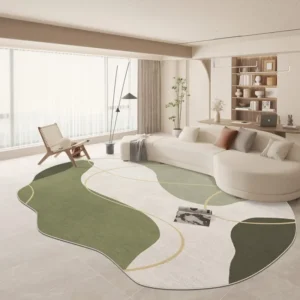 Large Area Green Rugs for Bedroom Nordic Living Room Decoration Shaped Carpet Irregular Plush Lounge Rug Home Thick Washable Mat
Rated 5.00 out of 5$54.94 – $346.41Price range: $54.94 through $346.41
Large Area Green Rugs for Bedroom Nordic Living Room Decoration Shaped Carpet Irregular Plush Lounge Rug Home Thick Washable Mat
Rated 5.00 out of 5$54.94 – $346.41Price range: $54.94 through $346.41 -
 Nordic Style Rugs for Bedroom Morandi Living Room Decoration Carpet Large Area Geometry Lounge Rug Home Cloakroom Non-slip Mat
Rated 5.00 out of 5$39.46 – $597.66Price range: $39.46 through $597.66
Nordic Style Rugs for Bedroom Morandi Living Room Decoration Carpet Large Area Geometry Lounge Rug Home Cloakroom Non-slip Mat
Rated 5.00 out of 5$39.46 – $597.66Price range: $39.46 through $597.66 -
 Irregular Shapes Living Room Decoration Carpet Modern Style Rugs for Bedroom Home Thicken Plush Rug Fluffy Soft Lounge Floor Mat
Rated 4.83 out of 5$55.84 – $347.37Price range: $55.84 through $347.37
Irregular Shapes Living Room Decoration Carpet Modern Style Rugs for Bedroom Home Thicken Plush Rug Fluffy Soft Lounge Floor Mat
Rated 4.83 out of 5$55.84 – $347.37Price range: $55.84 through $347.37

